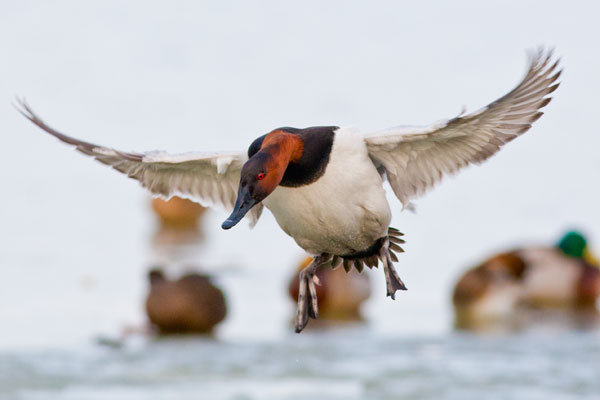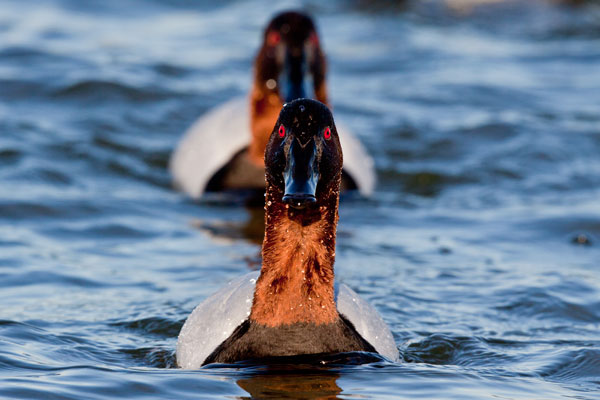September 10, 2012
By Brad Fitzpatrick

As dawn broke gray and cold over the Wye River East in Maryland, Jayson Wilt and his 11-year-old son, Dylan, sat in the blind watching their decoy spread rise and fall on the water's silvery surface. Across the river, a thin fog veiled the trees along the Wye Island National Wildlife Refuge. Dylan held his Winchester 1400 up, watching the December sky for the first sign of birds as Jayson worked the call.
It wasn't long until the first flights began coming up the river from Eastern Bay, the ducks moving in search of food. Jayson saw a large drake diver pitch away toward the decoy spread, its wings whistling as it descended, and immediately recognized it as a big bull canvasback. He motioned Dylan up and at the boy's shot the duck folded, landing in the choppy water with a heavy splash.
After celebrating the shot, Jayson sent the dog for the bird and father and son marveled at the unmatched beauty of the canvasback, its contrasting black and white plumage, its glossy mahogany head and the vibrant red eyes. Even in the dim light of that gray December morning the big drake looked magnificent.
Advertisement
For Jayson, who has been hunting and guiding for Black Duck Outfitters on Maryland's Eastern Shore for 25 years, that morning stands out as one of the finest days in his hunting career. For him, it represented the passage of a waterfowling legacy from his late father to his son, a chance to share a thrilling moment on the same stretch of water Jayson had hunted as a boy. But unlike days past, the bull canvasback Dylan shot wasn't an incidental passing diver that stumbled onto the decoy spread. Thanks to conservation efforts on the part of hunters and wildlife organizations, Dylan's drake was only the first bird that father and son would take that day.
"Throughout the morning, we watched hundreds of canvasbacks toll into the decoys," Jayson said. "We took turns picking our shots. The canvasback decoys like no other waterfowl, turning on a dime with the sound of wings cutting the wind like a small fighter jet."
To the Rescue
Advertisement
A bull canvasback is a majestic bird, a standout even among the ranks of America's varied and brilliant waterfowl species. The largest of North American divers, it has a wingspan approaching three feet. For many waterfowl hunters, a big drake canvasback is the ultimate prize. The fact that the canvasback can be hunted today is a testament to the efforts of groups like Ducks Unlimited and the foresight of conservation-minded hunters who fought to change the trend of declining populations in the mid-1980s.
A prairie pothole nester, canvasbacks typically migrate from their wintering grounds on the East and West Coasts to the plains of the central U.S., Canada and Alaska, beginning their return migration after the chicks have fledged in late summer or early autumn. Nesting success rates vary largely based upon the conditions in the prairie regions, and droughts can significantly reduce survival rates in ducklings. In addition, canvasback nests are often parasitized by redheads that lay their eggs in the nests and allow canvasback hens to incubate their clutches. In one study conducted in the Ruby Lake area of Nevada by biologists John Takekawa and Kammie Kruse, redheads parasitized as many as 90 percent of canvasback nests.
The steep decline in canvasback numbers in the 1980s was the result of reduced nesting habitat, low rates of duckling survival, drought and a host of other conditions. In addition, reduction of food sources in their wintering grounds along the coast, particularly the removal of submerged vegetation in bays along the East Coast, probably also played a major role in the decline of ducks.
In many ways, the drop in canvasback numbers represented a shift in waterfowl conservation as a whole. In the early 20th century, most of the declines in waterfowl populations could be attributed to unregulated hunting, particularly market hunting. Simply passing laws that controlled harvest and enforcing them was enough to allow duck numbers to rebound. Later, in the mid-20th century, habitat loss and chemical run-off became major threats to wetland birds. Conservation groups made efforts to preserve habitat and control the use of damaging chemicals that posed a risk to the survival of waterfowl.
With canvasbacks, however, there was no easy fix. It wasn't unregulated hunting that was responsible for the decline in their populations in the 1980s, it was environmental degradation. Understanding the drop in canvasback numbers was going to require a thorough understanding of the bird's complex ecology and the funding to conduct studies and take steps toward reversing the decline.
[nggallery id=17]
From the Brink
Since accurate, extensive data on canvasback populations does not exist prior to the mid-20th century, we may never know just how much danger the species was in at the turn of the century when tens of thousands were being shot by market hunters annually. We know that since the mid-1950s canvasback breeding population counts have hovered around a half-million birds, dropping significantly during the mid-80s and recovering during the '90s. The need for prairie habitat in which to nest and the dramatic impact rainfall levels have on reproduction cause canvasback numbers to fluctuate annually. When examining the population trends in the '80s versus the '90s and 2000s, it is clear that canvasback numbers have increased overall despite the fluctuations. During the early '80s, breeding populations dropped, and for much of that decade the population remained below a half-million birds with a steady decrease from 1980-85. Populations stayed low until the early '90s, when concerted efforts to restore wetland habitat in the prairie region and carefully regulated hunting produced an increase. Since '95, canvasback population counts have fallen below a half-million birds only twice, and even during those years never fell to the lows of the '80s.
James Dubovsky, Central Flyway representative for the Division of Migratory Bird Management at the U.S. Fish and Wildlife Service, hesitates to claim that canvasback populations have "recovered," though he does acknowledge increases from the mid-to-late '90s. These increases tend to show the efforts of conservation groups and their struggles to preserve and expand prairie wetlands habitat.
Like most prairie-nesting birds, canvasback numbers climbed with wetland abundance and grassland cover and with efforts by the North American Waterfowl Management Plan Joint Ventures in the prairies and the Conservation Reserve Program. Increases were significant, but not dramatic.
"If we can provide good habitat conditions and restrict harvest to levels they can sustain, canvasbacks have a great capacity to respond to those conditions and increase quickly.
Attack of the Clams
Bottom line: Hunters like Jayson Wilt are seeing more and more cans. And the new generation is getting the opportunity to hunt the King thanks to the foresight and long-term efforts of conservation funded by waterfowlers.
Despite these efforts, the canvasback faces problems. Chesapeake Bay and the surrounding areas are seeing more submerged aquatic vegetation being cleared for activities such as boating, removing a food source for wintering cans in the eastern half of the U.S. In addition, western canvasbacks face a reduction in available wintering food sources as invasive Asian clams displace native clams. These foreign clams, with their harder shells, provide no nutrition for the canvasbacks as they pass through the digestive system, in essence starving the ducks as they feed on them, according to Takekawa and Kruse's research. The largest threat, of course, remains the loss of wetland habitat in the essential prairie pothole region.
"Increased emphasis on energy production, high grain crop prices, and world demands for food and housing continue to reduce habitats," says Dubovsky. "The continued loss of wetlands in the prairies is very disconcerting. In addition, large blocks of native grasslands are being converted to agricultural production."
Today, the canvasback is once again a viable gamebird, preserved through the efforts of thousands of sportsmen. We have learned from canvasbacks that waterfowl recovery is multi-faceted, a combination of battling invasive species, preserving food sources, protecting wintering habitat and carving out a piece of the American landscape for wildlife amid the burgeoning expansion of human endeavors. It is a far cry from the days when regulating hunting was the simple remedy to increase duck numbers. The battle continues, but every time a new hunter like Dylan Wilt experiences the thrill of a big can dropping into the decoys, there is hope that the efforts of today's waterfowlers will continue for another generation and the king will reign supreme.


